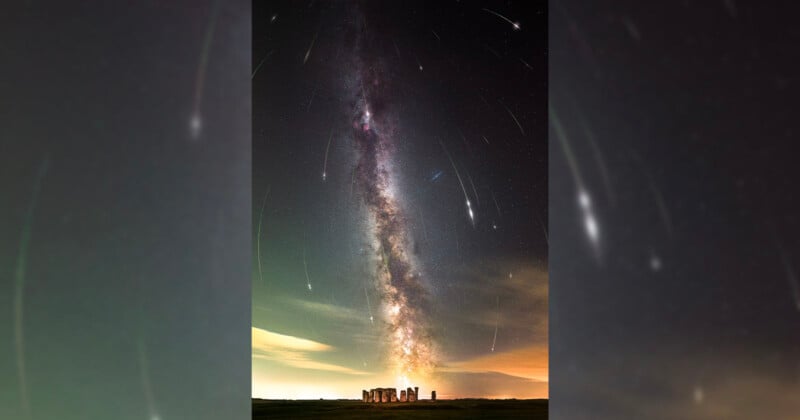Photographer Captures Perseid Meteor Shower Raining Down on Stonehenge

A photographer took advantage of last weekend’s Perseid meteor shower to capture an astonishing photo of fireballs raining down on Stonehenge.
Josh Dury executed the image perfectly which involved a day of editing to stitch together the 46 photos he captured on Friday night (August 9).
“On Friday evening, I made the decision to take the photograph of the Perseid meteor shower ’raining’ down on Stonehenge,” Dury tells PetaPixel.
“This is an image I have always wanted to capture in my mind for a long time. It was a matter of waiting for clear intervals to capture the meteors over a three-hour period. During this time I was able to execute 43 sub-images of the meteors.”
![]()
Stonehenge is located in Wiltshire, England, and is a prehistoric astronomical monument that aligns with sunrise on the summer solstice and sunset on the winter solstice. It is believed to have been constructed sometime between 3100 B.C. and 1600 B.C.
“Stonehenge has been close to my heart for many years with English Heritage having supported me for many years,” adds Dury.
“For me, the pertinent narrative of this ancient firework display, formed by some of the most ancient astronomical material of our solar system seemed a fitting tribute to the world-famous astronomical monument that is Stonehenge.”
Unsurprisingly, Dury’s image has blown up with NASA selecting it for Astronomy Picture of the Day.
“It has always been a lifelong ambition to be recognised by NASA and I consider this a privilege,” says the U.K.-based photographer. “My phone has been active non-stop for the past 48 hours.”
NASA notes that the reason the meteors appear to curve in the image is because of Dury’s 15mm diagonal fisheye lens.
“The meteor streaks can all be traced back to a single point on the sky called the radiant, here just off the top of the frame in the constellation of Perseus,” the space agency explains.
Dury took the photo from a permissive path adjacent to Stonehenge and also captured the central band of the Milky Way galaxy that runs near vertical through the image.
He uses a Sony a7S II with a Sigma 15mm DG GN attached. All perched on Benro Tortoise tripod.
More of Dury’s work can be found on his website, Instagram, Facebook, and X.
Image credits: Photographs by Josh Dury.